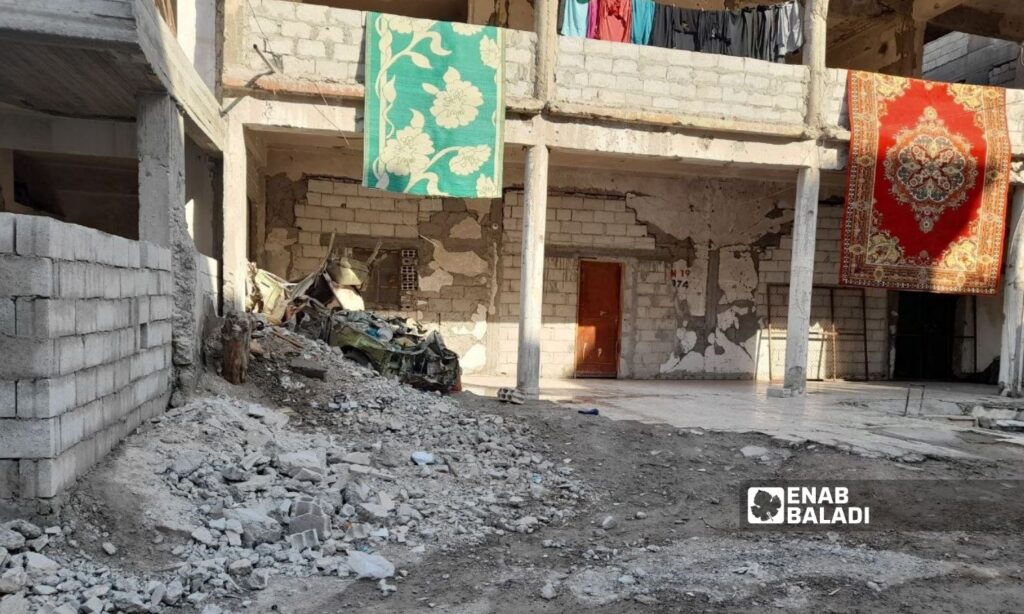Raqqa – Hussam al-Omar
The 45-year-old Faisal al-Juma’a refused to buy an apartment of 110 m2 in northeastern Raqqa city at a price of 6000 US dollars after he had seen the damages in the building.
Al-Juma’a told Enab Baladi that the owner of the apartment, which is located in the Bado (Bedouin) neighborhood in the center of Raqqa, told him that the building had been slightly damaged by the (IS-SDF) war, but when he visited the building, he found that the damage was more than he expected.
According to what engineers in Raqqa told Enab Baladi, the damage to some buildings threatens to collapse in the future, and this is what makes real estate dealers in the city of Raqqa offer apartments in partially destroyed buildings at low prices.
Reconstruction after destruction
Khaled al-Amir, 37, was forced to repair an apartment he owned in the al-Thakana neighborhood in Raqqa, although the apartments on the first and second floor were badly damaged, after he suffered a lot in the rental houses, according to what he told Enab Baladi.
Al-Amir added that he was forced to repair his damaged apartment and refused an offer from one of the contractors, in agreement with other owners of the building, which consists of ten apartments, including the demolition of the building and the construction of a new one on the same land, for fear of its collapse due to the damage caused by the war.
Al-Amir noted that the option of reconstructing the damaged apartments was a safer solution for him and the rest of the property owners, but the high financial cost of reconstruction pushed him towards rehabilitating his apartment.
“Profitable business”
Amir Mohammad, 50, owner of a real estate office in Raqqa, told Enab Baladi that most of those who buy apartments or partially damaged properties are looking for a quick profit by repairing them formally and selling them to other people.
The owner of the real estate office accused Raqqa municipality, which is run by the Autonomous Administration of North and East Syria (AANES), of neglecting to reconstruct the damaged apartments due to bribes, which the municipality’s workers receive from the landlords.
Municipality is the decision-maker
An employee of the Technical Services Department in the “People’s Municipality in Raqqa” (Enab Baladi withheld his name for security reasons) said the “municipality” is the decision-maker regarding the rehabilitation or repair of partially damaged buildings in the city and its countryside.
The employee indicated that people who wish to repair their apartments or rebuild destroyed buildings are obliged to obtain a building permit from Raqqa Municipality, which in turn inspects the building to be repaired, and assesses whether the repair is a “viable solution.”
The local employee stressed that the “municipality” is able to stop work on repairing partial damage or even cancel it if it deems that the safety of the building is in danger, according to technical and construction conditions determined by specialized engineers.
Raqqa-based civil engineer Ahmed al-Faraj said that the assessment of the possibility of not demolishing the partially damaged building and repairing it should be determined within engineering and construction controls that most investors and apartment owners do not abide by.
He warned that ignoring the restoration by the municipality and granting its licenses to the residents without observing the appropriate technical conditions may push Raqqa towards a “disaster” that may cause the collapse of dozens of buildings and threaten the lives of residents.
At the beginning of February 2020, the municipality of Raqqa issued a circular calling on the owners of destroyed properties in the city to remove the destroyed buildings because of the danger they pose to the lives of the people, especially those located near markets and residential communities, in addition to the buildings surrounding squares and public facilities.
According to what Enab Baladi monitored, a large number of buildings were removed according to the decision of the municipality of Raqqa to remove the buildings if the real estate owners did not abide by the decision within ten days, without prejudice to their ownership of these properties.
The United Nations Institute for Training and Research (UNITAR) said at least 3,326 buildings were completely destroyed in Raqqa, 3,962 buildings were severely damaged, and 5,493 partially destroyed, bringing the total of damaged buildings to 12,781.
The destruction in the governorate was distributed to various towns and villages. In al-Tabqa city, there are 207 completely destroyed buildings, 128 severely damaged buildings, and 152 partially destroyed buildings, with a total of 487 damaged buildings.
During 2017, Raqqa witnessed a 166-day battle between members of the Syrian Democratic Forces (SDF) and the Islamic State (IS) group.
The battles ended with the SDF taking control of the city in mid-October of the same year, backed by the US-led International Coalition. These battles led to the destruction of some buildings in the city, either partially or completely.
Warplanes and rocket launchers were used in the battles inside the city’s neighborhoods, and they played a major role in destroying buildings, in addition to the explosions that resulted from mines left behind by IS fighters.
The international organization Action On Armed Violence (AOAV) estimated in December 2019 that the number of artillery shells fired by the US-led International Coalition on Raqqa city at 30,000.











